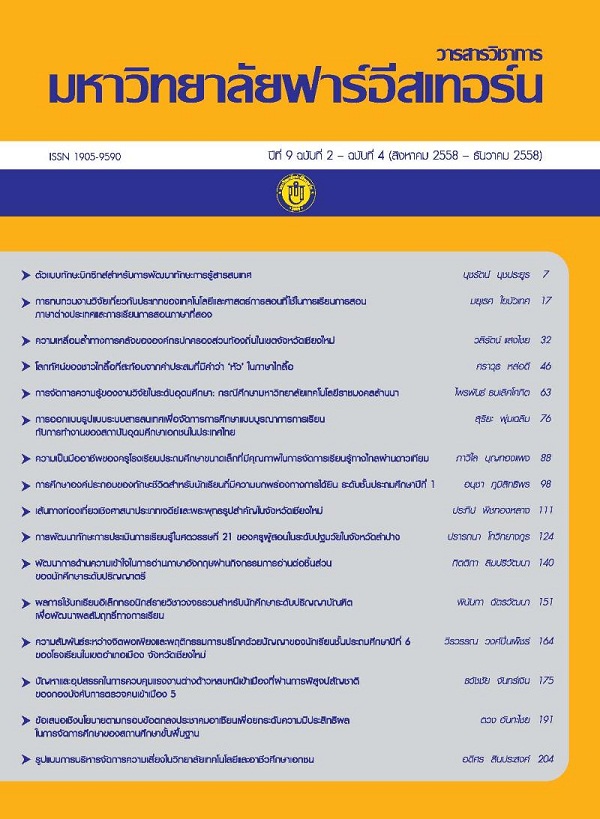ตัวแบบทักษะบิกซิกส์สำหรับการพัฒนาทักษะการรู้สารสนเทศ
Main Article Content
Abstract
บทความนี้มีวัตถุประสงค์เพื่ออธิบายถึงความสำคัญ กระบวนการ คุณลักษณะการรูส้ ารสนเทศ และแนวทาง
การส่งเสริมทักษะการรู้สารสนเทศตามกระบวนการของ The Big Six Skills การรู้สารสนเทศมีความสำคัญต่อ
ความสำเร็จของบุคคลในด้านต่างๆ ซึ่งจำเป็นสำหรับการดำรงชีวิต บุคคลจำเป็นต้องรู้สารสนเทศเพื่อปรับตนเอง
ให้เข้ากับสังคมการแข่งขัน โดยเฉพาะอย่างยิ่งการศึกษาในปัจจุบันตามพระราชบัญญัติการศึกษาแห่งชาติ พ.ศ. 2542
เน้นผู้เรียนเป็นสำคัญ ทำให้ผู้สอนมีบทบาทเพียงผู้ให้คำแนะนำชี้แนะ ทั้งนี้การรู้สารสนเทศมีองค์ประกอบของ
กระบวนการ คือ ความสามารถในการตระหนักว่าเมื่อใดจำเป็นต้องใช้สารสนเทศ (Know) การเข้าถึงสารสนเทศ
(Access) การประเมินสารสนเทศ (Evaluate) และความสามารถในการใช้สารสนเทศที่ต้องการอย่างมีประสิทธิภาพ
(Use) แนวทางการสง่ เสริมการรูส้ ารสนเทศตามตัวแบบการรูส้ ารสนเทศ (Information Literacy Model) ประกอบดว้ ย
1) การกำหนดเรื่องที่จะค้นหา (Task Definition) 2) การวางแผนกลยุทธ์การสืบค้น (Information Seeking Strategies)
3) การค้นหาและเข้าถึงสารสนเทศ (Location and Access) 4) การใช้สารสนเทศ (Use of Information)
5) การสังเคราะห์สารสนเทศ (Synthesis) 6) การประเมินสารสนเทศ (Evaluation) แนวทางการส่งเสริมทักษะ
การรู้สารสนเทศ (Information Literacy Skills) มีจุดเด่นที่การนำทักษะสารสนเทศและเทคโนโลยีสารสนเทศมา
ผสมผสานเข้าด้วยกัน เพื่อให้ผู้เรียนสามารถใช้เทคโนโลยีสารสนเทศเป็นเครื่องมือในการแสวงหาความรู้ ได้อย่าง
มีประสิทธิภาพ และสามารถนำไปประยุกต์ใช้ข้อมูลได้อย่างถูกต้อง เหมาะสมและเท่าทันข้อมูลที่มีความหลากหลาย
เพื่อพัฒนาตนเองสู่สังคมแห่งการเรียนรู้อย่างต่อเนื่อง
The article aims to describe the significance, process, information literacy characteristics and the
guideline to enhance information literacy according to the Big Six Skills Model. Information literacy had
the significance toward successful people in the other aspects that necessary for livelihood. People have
to realize the information to individual improvement in society and competition. In particularly the current
education as National Education Act B.E. 2542 (1999) focuses on children center and teachers were only
the advisers. Information literacy process consists of know, access, evaluate and use. The guideline
to enhance information literacy according to the big six skills model consists of 1) task definition
2) information seeking strategies 3) location and access 4) use of information 5) synthesis 6) evaluation.
Guideline to Information literacy process of the Big Six Skills was mixed information skills and information
technology together, the learners can able use information technology in information literacy tools and
can be use the multi information with correctly and appropriately for individual development to knowledge
based on society continuously.
Article Details
1. Any views and comments in the FEU Academic Review Journal are the authors’ views. The editorial staff have not to agree with those views and it is not considered as the editorial’s responsibility.
2. The responsibility of content and draft check of each article belongs to each author. In case, there is any lawsuit about copyright infringement. It is considered as the authors’ sole responsibility.
3. The article copyright belonging to the authors and the Far Eastern University are copyrighted legally. Republication must be received direct permission from the authors and the Far Eastern University in written form.
References
กรมวิชาการ. (2541). คู่มือพัฒนาโรงเรียนด้านการเรียนรู้. กรุงเทพฯ: กรมวิชาการ กระทรวงศึกษาธิการ.
ศรีเพ็ญ มะโน. (2536). การสร้างแบบจำลอง หลักสูตรวิชาการรู้สารนิเทศสำหรับนิสิตระดับปริญญาตรี โดยใช้วิธีการเชิงระบบ. วิทยานิพนธ์ศิลปศาสตรมหาบัณฑิต คณะบรรณารักษศาสตร์
และสารนิเทศศาสตร์ มหาวิทยาลัยศรีนครินทรวิโรฒประสานมิตร.
สุพัตรี วงศ์วอ. (2557). การเปรียบเทียบผลการเรียนและความสามารถในการคิดวิเคราะห์ เรื่อง ระบบเครือข่ายและการใช้อินเทอร์เน็ต ของนักเรียนชั้นมัธยมศึกษาปีที่ 2 ที่เรียนด้วยบทเรียนที่ใช้เว็บเทคโนโลยีแบบ Big six skills กับการสอนปกติ. วิทยานิพนธ์ศึกษาศาสตร์มหาบัณฑิต สาขาเทคโนโลยีการศึกษา. มหาวิทยาลัยมหาสารคาม.
อาชัญญา รัตนอุบล อำไพ ตีรณสาร คัคนางค์ มณีศรี วีระเทพ ปทุมเจริญวัฒนา กวิสรา รัตนากร
ยุรวัฒน์ คล้ายมงคล วรรัตน์ อภินันท์กูล และ รับขวัญ ภูษาแก้ว. (2550). รายงานการวิจัยการพัฒนารูปแบบการรู้สารสนเทศสำหรับสังคมไทย. กรุงเทพฯ: สำนักงานคณะกรรมการวิจัยแห่งชาติ.
American Library Association. (2010). Information Literacy Standards for Student Learning: Standards and Indicators. Retrieved January 12, 2011 from http://www.ala.org/ala/mgrps/divs /aasl/aaslproftools/informationpower/ InformationLiter acyStandards_final.pdf
Eisenberg, Michael B & Berkowitz, Robert E. (2001). The Big 6 Information Problem-Soliving Approach. Retrieved May 4, 2010 form http://www.big6.com
Doyle, C. (1992). Development of a Model of Information Literacy Outcome Measures within National Education Goals of 1990 (Education Policy). Thesis (ED.D.) Northern Arizona University. Retrieved January 13, 2011 from http://www.uni.net.th/dao/detail.nsp
Fortier , John D. ; Calvin, Potter J. ; Grady, Susan M. ; Lohr, Neah J. & Klein, Jim. (1998). Wisconsin’s Model Academic Standards for Information and Technology Literacy. Madison, WI: Wisconsin Department of Public Instruction.
SUNY Council of Library Directors Information Literacy Initiative. (2003). Retrieved January 7, 2010 from http://www.sunyconnectsunny edu/ili/final.htm
Wisconsin Association of Academic Librarians. (2006). Information Literacy Competencies and Criteria for Academic Libraries in Wisconsin. Retrieved March 9, 2010 form http://www.wla.lib.wi.us/waal/infolit/ilcc.htm
